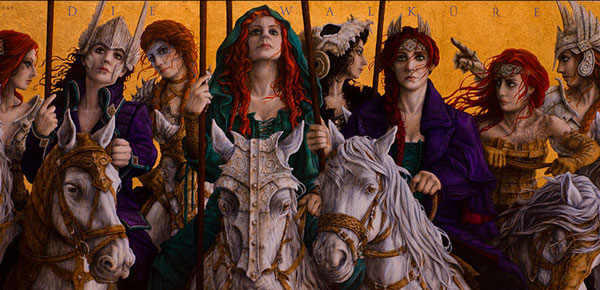Today, most of us think of the self as having two or three parts: a body, a mind, and perhaps – depending on your own religious convictions – a soul. The Vikings, too, thought of the self as having different components, but they believed in more and different components than we do.
The Viking self was an integral being; all of the parts added up to a more or less cohesive whole, as they do in our view of the self as well. But the parts could also function independently of one another, and could dissociate themselves from the others and go their separate ways under certain circumstances.
Norse religion was never made into a neat and tidy system while it was a living tradition. It was all informal and fluid. The Norse view of the self was another prime example of this resistance or apathy toward foisting a smooth order upon the roughness and boisterousness of lived experience.
The sources never offer a list or a “map” of the different parts that comprised the self. Different sources mention different and contradictory parts, and characterize them in different and contradictory ways. This tendency is too pervasive to be due to mere misunderstandings of what was originally a totally orderly and coherent system.
No worldview is, has ever been, or will ever be totally orderly and coherent. Those that are more coherent than others are generally those whose creators have gone out of their way to impose a rational organization upon them. But in the case of ancient, tribal religions that no one ever attempted to make into a doctrinally tidy system while they were still believed in and practiced, expecting the same level of tidiness one finds in the worldviews of individual philosophers, for example, is just plain ridiculous.
That being said, the sources do indicate that some parts of the self were more widely believed in, and the concepts more fully developed, than others.
The Viking Self
Let’s explore the four particularly widely remarked-upon parts of the Viking self and their dominant characterizations.
One of these four parts was physical, and the other three were spiritual. However, intriguingly, in the Norse religion, for something to be spiritual didn’t necessarily mean that it was truly immaterial or incorporeal. Instead, spirit was an especially fine kind of material substance, much like air – and, as in many ancient cultures, spirit was synonymous with breath.
Like Latin (animus/anima and spiritus) and Hebrew (ruach), Old Norse had one word for both breath and spirit: önd. Spiritual parts of a person could leave through her or his respiratory passages after death, and, while the person was still alive, spirits could enter him or her through the same respiratory passages. For example, when a spiritual part of a person detached itself from him or her and traveled to another person, the recipient of the spirit would often yawn or develop an itchy nose.
THE HAMR
The first of these four parts of the self, and the only one made of solid matter, was the hamr. Hamr literally meant “skin” or “hide,” but was essentially the same as what we today would call the “body.” It was the visible part of the self that housed the invisible parts.
However, whereas we tend to view the body as fixed and mostly unalterable, the Norse saw the hamr as something that could be changed radically by some people. Hamr was the central word in the vocabulary of shapeshifting, because the hamr was the “shape” that was “shifted” in that magical process. A shapeshifter was called a hamhleypa (“hamr-leaper”), and the verbal phrase for “to shift one’s shape” was skipta hömum (hömum was the dative form of hamr).
THE HUGR
One of the three invisible, spiritual parts of the self was the hugr. The hugr was someone’s personality or mind, the intangible part that corresponds most closely to what we mean when we speak of someone’s “inner self.” It encompassed thought, desire, intuition (the Old Norse word for “foreboding” was hugboð), and a person’s “presence” – the feeling others get when they’re around the person.

People described as having an especially strong hugr could make things happen somewhere far away without being physically present. At times, the hugr could even leave its original “owner” and enter into someone else. One could make a person sick by thinking about them in an envious way; the hugr of the thinker traveled to and entered into the one who was thought about and instigated physical reactions.
This could be done in a more or less involuntary and unconscious way, or as part of a deliberate attack. If it was an attack, it could have simply harmed the person directly, or it could have proceeded by more subtle and indirect means, making the victim sleepy, depressed, or generally weakened, so that the attacker could overpower the victim, whether physically or by getting the victim to do something that he or she wouldn’t otherwise do.
THE FYLGJA
The second of the spiritual parts of the self was the fylgja (plural fylgjur). The verb fylgja meant “to accompany,” “to help,” “to side with,” “to belong to,” “to follow,” “to lead,” “to guide,” or “to pursue” depending on the context.
The fylgja spirit did all of those many things, and the best translation of the noun fylgja is probably “attendant spirit,” in both senses of the word “attendant” – one who accompanies and one who helps.
Fylgjur were always visible to those with second sight (the ability to see invisible, spiritual phenomena on a regular basis), and they were visible to those without second sight during dreams and at the moment of the death of the “owner.”
Just before someone died, he or she sometimes caught a glimpse of her or his dead fylgja. In this and other ways, the well-being of the fylgja and that of the “owner” were intimately bound up with one another. This shouldn’t surprise us, since, after all, the fylgja was part of the owner on some level, even though it could separate itself from the rest of the self at times, just as could all of the other parts of the self.
Attendant spirits
The fylgja often worked to protect the person of which it was a part. In one of the sagas, for example, a sorceress planned to kill a man at an upcoming party. The man’s fylgja warned him about the danger in dreams for three nights in a row, and then finally gave him an illness that prevented him from being able to go to the party, thereby saving his life.

The only constant in the visual form these attendant spirits assumed was that they were always female. Sometimes they appeared in the form of a human woman, but more commonly they appeared in the form of an animal. The particular animal form taken by the fylgja often signaled something about the person’s character. Someone with a bear for a fylgja was likely high-born, while someone with a wolf fylgja was bound to be especially aggressive, and someone with a fox fylgja was cunning and shrewd. Sometimes, however, the form in which the fylgja appeared could be situational. For example, an attacking army might be accompanied by a host of wolf fylgjur.
To avoid a possible confusion, the fylgja having an animal form was different from a person shifting his or her shape (hamr) into that of an animal. The fylgja accompanied its “owner” in a spiritual capacity while he or she was in his or her usual form, while shapeshifting involved transforming one’s physical, sensory presence.
THE HAMINGJA
The final part of the Viking self we’ll examine here is the hamingja, “luck” or “fortune” (plural hamingjur). In the words of Old Norse scholar Bettina Sommer, “luck was a quality inherent in the man and his lineage, a part of his personality similar to his strength, intelligence, or skill with weapons, at once both the cause and the expression of the success, wealth, and power of a family.” The surest test of the strength of a person’s hamingja was his or her fortune in battle.
Like the fylgja, the hamingja was always female, even for men. The appearance of the hamingja is seldom described in the sources, but Viga-Glum’s Saga provides a striking image of one: an enormous woman whose shoulders were so wide that they touched two separate mountains.
The hamingja was typically passed down through family lines. Naming a newborn child after a relative would ensure, or at least increase the likelihood, that the relative’s hamingja would be passed down to the child. Sometimes it seems like the dying or dead person could decide to whom his or her hamingja went, and at other times it seems like the hamingja decided herself.
A living person could also lend his or her hamingja to others to accompany them on particular endeavors in which extra luck would be of great use, such as a battle or a long and perilous journey.
The lines between the hamingjur, fylgjur, and Valkyries were especially blurry. All were female helping spirits, and all at least sometimes moved from one person to one of that person’s children or grandchildren when the original “owner” or partner died.
Src. The Viking Spirit by Daniel MCCoy
The Viking Spirit is the ultimate introduction to the timeless splendor of Norse mythology and religion for the 21st Century. You’ll learn about the Vikings’ gods and goddesses, their concept of fate, their views on the afterlife, their moral code, how they thought the universe was structured, how they practiced their religion, the role that magic played in their lives, and much more!




